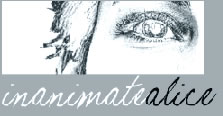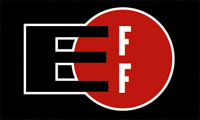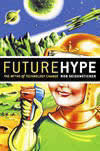 With last week’s launch of it’s TV over the Internet service, a raft of integrated net-based services and a slew of new hardware devices, BT has relauched itself as a multi-media service provider instead of a plain old utility company. The BT Internet Radio shows another face of BT’s rebranding. It’s a slickly designed consumer electrical product aimed directly at the growing digital radio sector.
With last week’s launch of it’s TV over the Internet service, a raft of integrated net-based services and a slew of new hardware devices, BT has relauched itself as a multi-media service provider instead of a plain old utility company. The BT Internet Radio shows another face of BT’s rebranding. It’s a slickly designed consumer electrical product aimed directly at the growing digital radio sector.
The design of the device itself echoes Apple’s trademark austere, white aesthetic. Organically shaped, it has no straight edges or corners and is slightly flared towards the base. Wraparound silver mesh panels add some contrast and a front centred LED displays information in a soft blue light. On top are a series of quite ‘plasticy’ buttons. Two larger buttons provide volume control and menu navigation and various others control playback, station memory, alarm and other functions.
Setting it up is a breeze. A simple press button starts the device scanning for your wireless network. You log on using the scrolling navigation button to enter your normal network password and the radio takes care of the rest.
Once online, stations are accessed through the same navigation button. They are grouped by location or genre, though there doesn’t appear to be a way just to browse all available stations. A series of sub-menus gives access to the features of each station. A choice between live and on demand material is visible where archived material is available. This means you can access services like the BBC’s listen-again service, picking programmes from all the recent BBC broadcasts for the last seven days. More sub menus allow you to choose programmes and days where appropriate.
 Choosing between stations is a bit of a hit and miss affair. If your tastes tend towards anything beyond the mainstream categorizations (rock, pop, dance, hip hop etc) you’ll struggle to find the music you want to hear. This, of course, isn’t BT’s fault. The device uses the Reciva Internet Portal to aggregate its stations. If you access the Reciva Website (Reciva) you can find some more detail on the content of stations but, since Reciva (like the Gracenote database) allows users to add information there are some frustratingly arbitrary categorizations. That said, there are over 5000 stations available and, once I located Resonance FM under the experimental section I was happily listening to an assortment of droning and scraping, Bollywood soundtracks and post-modern poetry.
Choosing between stations is a bit of a hit and miss affair. If your tastes tend towards anything beyond the mainstream categorizations (rock, pop, dance, hip hop etc) you’ll struggle to find the music you want to hear. This, of course, isn’t BT’s fault. The device uses the Reciva Internet Portal to aggregate its stations. If you access the Reciva Website (Reciva) you can find some more detail on the content of stations but, since Reciva (like the Gracenote database) allows users to add information there are some frustratingly arbitrary categorizations. That said, there are over 5000 stations available and, once I located Resonance FM under the experimental section I was happily listening to an assortment of droning and scraping, Bollywood soundtracks and post-modern poetry.
Sound quality is quite adequate and better than that produced by most internal computer speakers. The sound is deep and clear with none of the echoing or breakup that DAB radio is prone to. There are, however, a couple of niggles with sound adjustment. There is no way to adjust bass or treble and the volume control does not automatically increase when held down, meaning you have to keep pressing to raise or lower volume. Unlike DAB, the radio doesn’t display any info (such as such as track titles) about the source.
Using the unit was no problem though there were some irritations. It tends to hang on to the last programme played and starts up replaying that every time. In the case of a live station that’s ok but for archived content it can become annoying. The radio is also subject to same problems you would encounter with any wireless device: proximity to router and the number of walls in between can affect reception. I noticed a tendency for buffering in most locations in which I tried. Access to a signal is entirely dependent on your internet connection being on. My router drops the line when it isn’t in use therefore the auto-play alarm function is no use. When the unit reconnects to the network after being switched off, it uses the saved security key however I found that often the logon failed a second attempt was required.
 The device can access and playback MP3 or other audio files from a networked PC. An extremely useful feature and one that really capitalizes on the network power of the unit. It probably would have done the most to sell this device to me. In practice it was unable to connect to my PC so I had to leave the feature untested. Typically, macs are not supported and I was unable to access my sizable MP3 collection via either of the macs on the network. It’s not surprising that BT have chosen to adopt Windows technology for integration with computers but it is disappointing that they couldn’t have adopted an interoperable standard which would have supported any operating system.
The device can access and playback MP3 or other audio files from a networked PC. An extremely useful feature and one that really capitalizes on the network power of the unit. It probably would have done the most to sell this device to me. In practice it was unable to connect to my PC so I had to leave the feature untested. Typically, macs are not supported and I was unable to access my sizable MP3 collection via either of the macs on the network. It’s not surprising that BT have chosen to adopt Windows technology for integration with computers but it is disappointing that they couldn’t have adopted an interoperable standard which would have supported any operating system.
Given that Windows-centric tendency I wonder exactly who the Internet Radio will be useful to? On one hand it brings a host of Internet radio stations and a variety of useful services and features into one portable unit. It’s easy to set up and use and, in the right circumstances, has the potential to integrate with an existing network to provide extended access to shared music files.
On the other hand, it is only Windows compatible and therefore restricted in terms of both OS and DRM technologies.
Conclusion
If you are already streaming audio over your wireless network, there isn’t a whole lot of extra functionality in this box. Since a wireless network is a necessary prerequisite for the unit to work, I have to wonder how many people will find it sufficiently superior to their existing methods of playback to make it worth the £120 price tag.
Score: 75%
 It’s been a cult movie staple for over 15 years but, from Friday, you’ll be able to interact with Mr Pink, Mr White, Nice Guy Eddie and the rest of Quentin Tarantino’s be-suited robbers as Eidos launches Reservoir Dogs, the game.
It’s been a cult movie staple for over 15 years but, from Friday, you’ll be able to interact with Mr Pink, Mr White, Nice Guy Eddie and the rest of Quentin Tarantino’s be-suited robbers as Eidos launches Reservoir Dogs, the game. We said the graphics were realistic but so is the dialogue and each level is accompanied by excerpts, with each character having over 200 lines.
We said the graphics were realistic but so is the dialogue and each level is accompanied by excerpts, with each character having over 200 lines. This approach includes the music. Eidos licensed all the original music from the film but more was required to fit the length of the game. Some was written in-house and additional tracks were licensed including some stupendously funky 70’s driving music to accompany the car chase.
This approach includes the music. Eidos licensed all the original music from the film but more was required to fit the length of the game. Some was written in-house and additional tracks were licensed including some stupendously funky 70’s driving music to accompany the car chase. Desktop computing will be dead by the end of the decade and laptops will be following shortly after. That was the view of Graham Brown-Martin of Handheld Learning in an entertaining presentation at day two of the EIEF.
Desktop computing will be dead by the end of the decade and laptops will be following shortly after. That was the view of Graham Brown-Martin of Handheld Learning in an entertaining presentation at day two of the EIEF. As an illustration of this, and of his extremely cool mobile phone, Brown-Martin demonstrated a home made remix of the Snakes on a Plane teaser, edited with a mobile and a Macbook. The result was uploaded directly to YouTube from the phone then downloaded again (wirelessly) using a Nokia Internet tablet.
As an illustration of this, and of his extremely cool mobile phone, Brown-Martin demonstrated a home made remix of the Snakes on a Plane teaser, edited with a mobile and a Macbook. The result was uploaded directly to YouTube from the phone then downloaded again (wirelessly) using a Nokia Internet tablet. Inanimate Alice is a story about a games developer called Alice created by Kate Pullinger, Ian Harper & Chris Joseph. The story tells of her childhood and how she created and played games as she grew up in different countries around the world. Inanimate Alice a multi part episodic, interactive game which is available online at
Inanimate Alice is a story about a games developer called Alice created by Kate Pullinger, Ian Harper & Chris Joseph. The story tells of her childhood and how she created and played games as she grew up in different countries around the world. Inanimate Alice a multi part episodic, interactive game which is available online at  In a question and answer session the trio revealed that the project is aimed at the widest possible audience (especially non-gamers) but is currently most popular amongst 16-35 year old females.
In a question and answer session the trio revealed that the project is aimed at the widest possible audience (especially non-gamers) but is currently most popular amongst 16-35 year old females. The second day of EIEF got underway with seminar on media convergence with the first speaker being Rosanna Sun of
The second day of EIEF got underway with seminar on media convergence with the first speaker being Rosanna Sun of  Each different media (movie, games etc) has different production schedules and sharing ‘assets’ amongst them became an enormous scheduling problem. Visual fx shots are typically done last in movies, for games they needed to be ready 6 months prior to launch. This meant some sequences had to be literally re-directed from movie sequences.
Each different media (movie, games etc) has different production schedules and sharing ‘assets’ amongst them became an enormous scheduling problem. Visual fx shots are typically done last in movies, for games they needed to be ready 6 months prior to launch. This meant some sequences had to be literally re-directed from movie sequences. During Q&A
During Q&A The Long Tail is an important manual for the new economics of the Internet and digital culture. As well as demystifying the numbers it provides an essential guide to how to navigate a world where everything is available, all the time. Score: 95%
The Long Tail is an important manual for the new economics of the Internet and digital culture. As well as demystifying the numbers it provides an essential guide to how to navigate a world where everything is available, all the time. Score: 95% The Long Tail effect is not limited to buying and selling, the process by which the book was written is a case in point. Anderson (editor in chief of Wired magazine) published the
The Long Tail effect is not limited to buying and selling, the process by which the book was written is a case in point. Anderson (editor in chief of Wired magazine) published the  Some have taken this to mean that Anderson is sounding the death knell for blockbusters, something which he was at pains to counter on his blog, “Hits Aren’t Dead” he said, “I never said they were. What is dead is the monopoly of the hit. For too long hits or products intended to be hits have had the stage to themselves, because only hit-centric companies had access to the retail channel and the retail channel only had room for best-sellers. But now blockbusters must share the stage with a million niche products, and this will lead to a very different marketplace.”
Some have taken this to mean that Anderson is sounding the death knell for blockbusters, something which he was at pains to counter on his blog, “Hits Aren’t Dead” he said, “I never said they were. What is dead is the monopoly of the hit. For too long hits or products intended to be hits have had the stage to themselves, because only hit-centric companies had access to the retail channel and the retail channel only had room for best-sellers. But now blockbusters must share the stage with a million niche products, and this will lead to a very different marketplace.” The BPI continued its policy of clamping down on illegal file sharing this week, when it contacted UK ISPs Cable and Wireless and Tiscali with requests to suspend 59 accounts.
The BPI continued its policy of clamping down on illegal file sharing this week, when it contacted UK ISPs Cable and Wireless and Tiscali with requests to suspend 59 accounts. In a statement on 12th July, the BPI stated “Early responses from both companies suggest that they will suspend accounts which have clearly been used for illegal filesharing” and indicated that it could supply detailed evidence on the other 16 Tiscali addresses. In an interview on More Four News Tiscali spokesman Richard Ayres said Tiscali’s message to the record industry is “Come to us, give us the details and we’ll absolutely work with you.” Which would seem to be in contradiction of Tiscali’s own letter, which also stated that “Tiscali does not intend to require its customers to enter into the undertakings proposed by you and, in any event, our initial view is that they are more restrictive than is reasonable or necessary.”
In a statement on 12th July, the BPI stated “Early responses from both companies suggest that they will suspend accounts which have clearly been used for illegal filesharing” and indicated that it could supply detailed evidence on the other 16 Tiscali addresses. In an interview on More Four News Tiscali spokesman Richard Ayres said Tiscali’s message to the record industry is “Come to us, give us the details and we’ll absolutely work with you.” Which would seem to be in contradiction of Tiscali’s own letter, which also stated that “Tiscali does not intend to require its customers to enter into the undertakings proposed by you and, in any event, our initial view is that they are more restrictive than is reasonable or necessary.” Coincidentally, the BPI action comes at the same time that the (US based)
Coincidentally, the BPI action comes at the same time that the (US based)  Title: Future Hype: The Myths of Technology Change
Title: Future Hype: The Myths of Technology Change  In other areas Seidensticker is less compelling. He sometimes glosses over details to make his point. Describing redundant proprietary software formats (WordStar is often cited as an example, the most successful word processor of its time, its file format is now unreadable by all modern applications) he neglects to mention developments such as Open Source software, XML or research into digital archiving, all of which are making progress to eliminating exactly that kind of problem.
In other areas Seidensticker is less compelling. He sometimes glosses over details to make his point. Describing redundant proprietary software formats (WordStar is often cited as an example, the most successful word processor of its time, its file format is now unreadable by all modern applications) he neglects to mention developments such as Open Source software, XML or research into digital archiving, all of which are making progress to eliminating exactly that kind of problem. The US Democratic party has adopted net-neutrality as a party-political issue following the rejection of a second pro-neutrality amendment in a vote late last week.
The US Democratic party has adopted net-neutrality as a party-political issue following the rejection of a second pro-neutrality amendment in a vote late last week. Former presidential candidate Senator John Kerry commented, “This vote was a gift to cable and telephone companies, and a slap in the face of every Internet user and consumer.” Another Democrat, Senator Ron Wyden, placed a ‘hold’ on the bill which temporarily stops further progress but a decision is inevitable and both sides are marshaling forces behind their cause.
Former presidential candidate Senator John Kerry commented, “This vote was a gift to cable and telephone companies, and a slap in the face of every Internet user and consumer.” Another Democrat, Senator Ron Wyden, placed a ‘hold’ on the bill which temporarily stops further progress but a decision is inevitable and both sides are marshaling forces behind their cause. Last week the French legislature approved a new law which could radically change the landscape of digital audio. The so-called ‘iTunes Law’ is designed to break the control hardware manufacturers exert over the type of content that can be played by their digital music players and software. The result would be that companies such as Apple, Microsoft and Napster would have to make their data formats interoperable, thereby opening their systems to music from rivals. A regulatory body could be set up to police the sector.
Last week the French legislature approved a new law which could radically change the landscape of digital audio. The so-called ‘iTunes Law’ is designed to break the control hardware manufacturers exert over the type of content that can be played by their digital music players and software. The result would be that companies such as Apple, Microsoft and Napster would have to make their data formats interoperable, thereby opening their systems to music from rivals. A regulatory body could be set up to police the sector. The iTunes Law does, however, leave a get-out for the tech companies. A newly-added clause permits artists to exercise control over additional DRM. In short, artists could object to their music being transferred into other formats, thereby ensuring that current practices could continue unaffected. This loophole would require renegotiation of existing contracts, something Apple et al may wish to avoid given record companies’ desire to recoup perceived losses due to piracy. Lawyers observed that the new law is complex and its impact will be difficult to judge until it is tested in court.
The iTunes Law does, however, leave a get-out for the tech companies. A newly-added clause permits artists to exercise control over additional DRM. In short, artists could object to their music being transferred into other formats, thereby ensuring that current practices could continue unaffected. This loophole would require renegotiation of existing contracts, something Apple et al may wish to avoid given record companies’ desire to recoup perceived losses due to piracy. Lawyers observed that the new law is complex and its impact will be difficult to judge until it is tested in court.